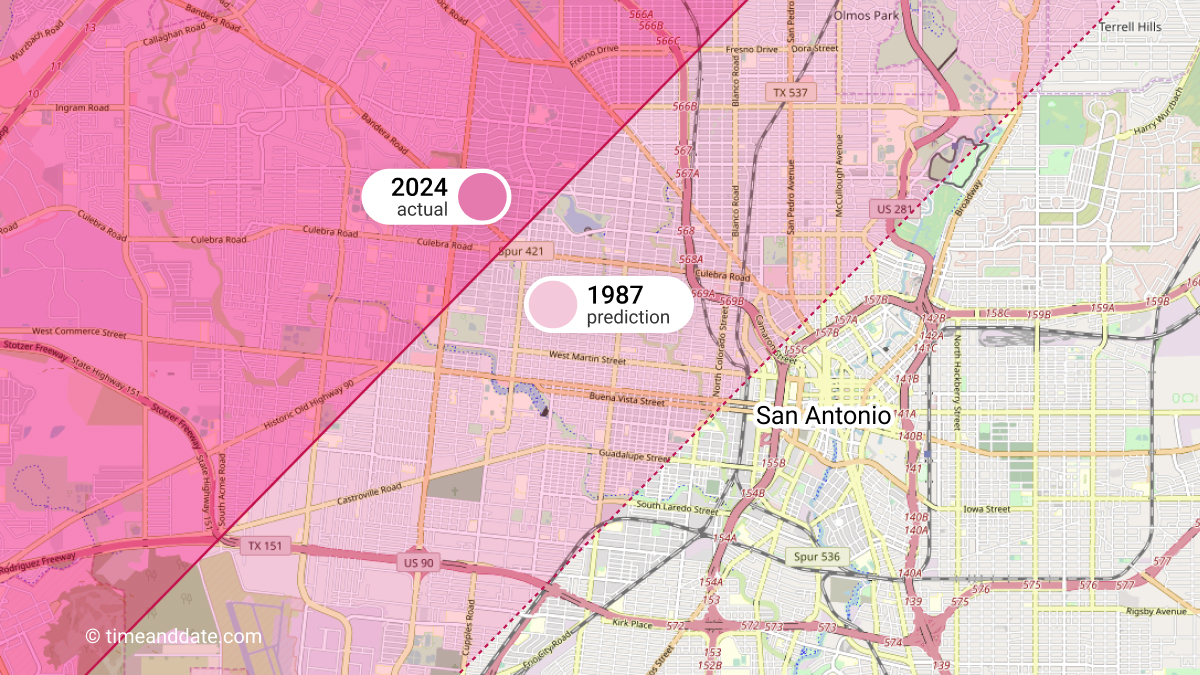Earth Slows Down, but Remains Unpredictable
Following a recent run of the shortest days ever recorded by atomic clocks, Earth’s rotational speed may be slowing.

Earth completes one spin on its axis (with respect to the Sun) every 24 hours—give or take a few milliseconds.
©ESA
Earth’s Acceleration Ends
In the past few years, Earth’s spin speeded up. It was at its swiftest in June 2022, which included the shortest-ever days as measured by atomic clocks.
Since then, however, the trend has reversed. In 2023, for the first time in seven years, the average length of day became longer. Meanwhile, the latest predictions suggest this slowdown may continue into 2025.
Review: Earth Speeds Up
In general, Earth’s rotational speed is decreasing: around 100 million years ago, a day on Earth was only 23 hours long. This gradual slowdown is caused by the gravitational pull of the Moon acting as a gentle brake on Earth’s spin.
However, during the past decade, Earth speeded up. Here at timeanddate, we kept a close eye on this development—and its consequences.
2020: Earth in a Hurry
We revealed that the year 2020 had included the 28 shortest days since the invention of the atomic clock.
2021: On Course for a Negative Leap Second?
Earth’s acceleration raised the possibility of our clocks having to skip a second to keep up.
2022: New Record for Shortest Day
In June 2022, Earth beat its record for the shortest day of the atomic clock era.


Between 2019 and 2022, the length of day shortened. In 2019, the average length of day was +0.39 milliseconds; in 2022, it was -0.25 milliseconds.
©timeanddate
2022: New Rule for Leap Seconds?
Partly as a result of Earth’s unexpected speeding up, the General Conference on Weights and Measures (CGPM) proposed a rule change that would do away with leap seconds for at least 100 years.
2023/2024: The Texas Cities That Lost an Eclipse
We looked at how Earth’s unpredictable rotation meant that calculations carried out in the 1980s for solar eclipses in October 2023 and April 2024 were now off by a few miles.


The path of totality for the 2024 solar eclipse across North America was farther to the west than had been predicted in 1987—a consequence of Earth’s faster-than-expected rotation.
©timeanddate.com
2023 and 2024: Earth Slows Down
The speed of Earth’s daily rotation is recorded as a number called ‘length of day’. This number is the difference between (a) the time it takes Earth to spin once on its axis with respect to the Sun, and (b) 86,400 seconds (which equals 24 hours).
Look up length of day for today or any other date
The following table shows the average length of day in milliseconds (ms) for the years 2016 to 2024. The average decreased from +1.34 ms in 2016 to a minimum of -0.25 ms in 2022. But the average day lengthened to -0.08 ms in 2023, and is predicted to be longer again in 2024.
Earth’s Rotational Speed, 2016–2024
| Year | Length of Day |
|---|---|
| 2016 | +1.34 ms |
| 2017 | +1.03 ms |
| 2018 | +0.69 ms |
| 2019 | +0.39 ms |
| 2020 | 0.00 ms |
| 2021 | -0.18 ms |
| 2022 | -0.25 ms |
| 2023 | -0.08 ms |
| 2024 | +0.24 ms |
Sources: timeanddate.com; IERS
Looking ahead into the first part of next year, the very latest predictions indicate the length of day could reach up to +1.63 ms in March 2025. This would be the longest day on record since March 2019.
Beyond 2024: Will Earth’s Slowdown Continue?
Data on the length of day is provided by the International Earth Rotation and Reference Systems Service (IERS). As well as supplying daily measurements, IERS also publishes predictions for up to a year in advance.
Beyond this, however, predictions become problematic. Changes in Earth’s rotational speed are affected by the complex motion of Earth’s core, oceans, and atmosphere, plus other factors.
“We’ve tried internally modeling things for the next two or more years,” Nick Stamatakos, a member of the IERS Directing Board, told timeanddate in 2021. “But we run into trouble predicting more than six months or one year ahead.”
In July 2022, we talked to astronomer Leonid Zotov as he was preparing a presentation on Earth’s rotation for the Asia Oceania Geosciences Society. At that time, he thought there was a “70 percent chance” that the length of day had reached a minimum.
When we caught up with Dr Zotov this month, in April 2024, he was sticking to his prediction—with a caveat. “I think the Earth will decelerate,” he said. “But the future will show if that’s right.”